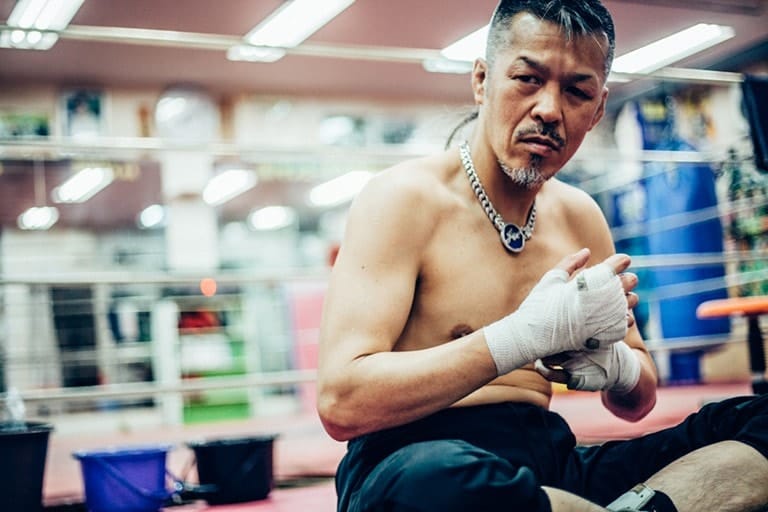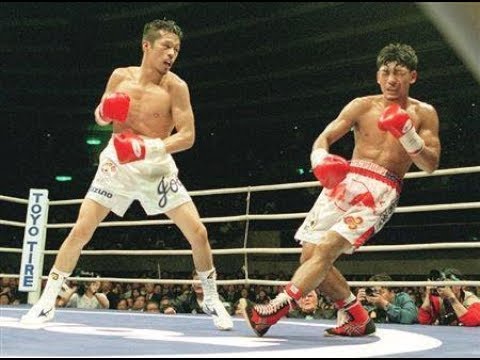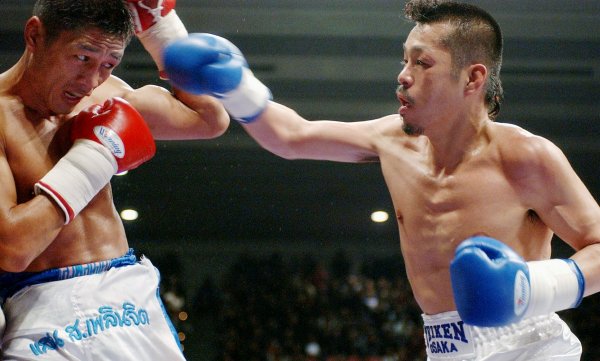Three time World Boxing Council (WBC) World Bantamweight champion Jôichirô Tatsuyôshi, is the subject of Joe, Tomorrow: 20 years with Joichiro Tatsuyoshi (2015), directed by Junji Sakamoto and produced by King Records. Sakamoto is no stranger to the ring, having delved into the boxing world with three of his features, including his celebrated 1989 debut feature Knockout, made the same year Tatsuyôshi went pro.

Source: mocmmxw.com
The parallel between director and subject is but one layer of this documentary’s fascination.
Another is its spanning of two decades in such a brisk 80 minute runtime. Further still is just how deep and filial Tatsuyôshi is revealed to be.
Sakamoto filmed their interviews periodically between 1995, just after the loss of Tatsuyôshi’s first world title, and premiered the documentary at the 2015 Tokyo International Film Festival, 6 years after his final bout. A brief exposition covers the first 5 ascendant years of Tatsuyôshi’s pro career, and with little else, we drop into a career at its first moment of crisis.
With Joe Tomorrow, Sakamoto does’t aim to satiate a hunger for training or fight montages, nor does he pour over archival photos or staged setups for artistic effect. Indeed, this is not a film obsessed over technique, either on the part of its subject or in its own construction. One might be tempted to say that the almost brazen simplicity and poetic clarity of the film’s structure reflects Tatsuyôshi’s own honed tactics inside the ring and sheer honesty outside.
Joe Tomorrow is an uncommonly pure character study that delves into this legendary boxer’s mind frame, revealed entirely through the athlete’s own words, issuing from the trust shared between director and subject. Tatsuyoshi is ever present in the frame, and from interview to interview he ages before us… though he never seems to change fundamentally as a person.
Rise and Fall and Rise And Fall
Jôichirô Tatsuyôshi, called Joe for short, was born in Kurashiki, Okayama Prefecture in Japan in 1970. He grew up largely under the single parenthood of his father who happened to be an avid fan of boxing, and who looms large in Tatsuyôshi’s dialogues throughout the film.

Source: YouTube.com
That influence, and the boxing fundamentals that his father taught him would carry over into a life path. By 17, he would have a near undefeated amateur record of 18-1-0 (the single loss of which knocked him out of Olympic candidacy), and would end his pro career at age 39 with a record of 20-7-1.
That his pro record appears less than remarkable dismisses the extent of both his meteoric rise, overlooks the impediment of injury along his course, and says nothing of his enduring popularity. Tatsuyôshi won the Japanese Bantamweight title in only his fourth professional bout (1990), and took the WBC World Bantamweight title on the occasion of his 8th (1991) in a match against Greg Richardson, the fastest of any Japanese boxer at the time for both.
For some perspective on the scale of his WBC title win, it has been matched only once in the intervening 30 years, by Nobuo Nashiro (2006).
Tatsuyôshi is known for his precariously low, center-of-chest guard, his snappy counter punch, focused short combinations, and drastic level changes.
His style is a fairly clean one, in that he doesn’t waste energy and prefers sharp deliberate attacks, but there is a touch of the showman in it.
His dips and rolls are huge and sometimes feel like he is one whole second ahead of his opponent.
Tatsuyôshi is also never terribly concerned about occupying center ring. To the contrary he likes to work clockwise around his opponents, maintaining a relatively long distance that he can easily close with his over 5ft jab (one of his most powerful weapons).
Again this makes his technique crystal clear from an observational standpoint, though his offensive precision is sometimes muddied by a brazen willingness to eat punches.
Tatsuyôshi would lose his initial WBC title on his first defense against Victor Rabanales (1993), from whom he would reclaim it as an interim title two bouts later. Sadly he was forced to relinquish that interim title due to a retinal injury, one of two such injuries that would sideline him for a year and nearly forcibly retire him precisely when he needed to carry the momentum of his ascent.
Stubborn as he is, Tatsuyoshi would claw his way back up the ranks to regain that beloved World Bantamweight title from then undefeated Sirimongkol Singwancha on his 20th bout (1997), a victory fortified by two subsequent title defenses. An accomplishment in and of itself, is the fact that Tatsuyôshi is one of only 4 fighters to take down Sirimongkol Singwancha across a staggering 97-4-0 record.
Alas, Tatsuyôshi would persist past his stated intent to retire after two title defenses, losing to Veeraphol Sahaprom on his third. Before aging out of pro licensure in Japan at 36, he hit a high note note with two wins in 2002 and 2003 respectively during a span of spotty activity.
After 5 years outside of the ring, Tatsuyôshi would inexplicably resurface in Thailand in 2008, banking one more win and one loss for his pro record before falling into the tacit retirement that continues to this day. The tacit nature of that retirement, and the boxer’s relationship to the very idea of retirement, is one such focus of Joe Tomorrow.
These are merely the anecdotes of Tatsuyôshi’s career though, and while there is undeniable drama in the peaks and valleys, Joe Tomorrow takes us not into the cliff notes but into the mind of that boxer. Sakamoto’s film flows inside the gaps of those anecdotes, and lets us observe the self analysis of a man who is not only a boxer, but also a father, a husband and a son.

Source: asianboxing.info
In what is ultimately a series of self-reflections, one can see and hear the relative consistency of Tatsuyôshi’s thoughts, compulsions and ideas over time while he adapts to circumstances and modifies his targets. He exhibits an uncommon ownership of his stubbornness, uncommon in that it is both unapologetic and yet somehow unpretentious. Sakamoto said in an interview, that it wasn’t so much Joe that changed over time as it was himself.
Inside and Out
As a boxing film, Joe Tomorrow defocuses the minutiae of the sport itself, and narrows its depth on the existential and philosophical element. Tatsuyôshi’s bouts are shown not in their entirety but in brief series of 2 or 3 still frames, yet one’s heart still sinks or swells depending on the result. Sakamoto brings us to Tatsuyôshi after these pivotal bouts and life events, such as the passing of his father, to catch him in that liminal space between reflection and prediction.
To supplement Joe Tomorrow, whose intent is more personal, the original Japanese broadcasts of Tatsuyoushi’s first title win against Greg Richardson (1991), both bouts against Daniel Zaragoza (1996-97), his attempt at the Super Bantamweight title against Yasuei Yakushiji (1994), his regaining the World Bantamweight Title from Sirimongkol Singwancha and subsequent title defense against Paulie Ayala, and the loss of his third and final title against Veeraphol Sahaprom (1998), can all be watched on youtube. These make for an incredible resource and the perfect way to learn what Tatsuyôshi was like inside the ring, revealing not only his skill, but also his profound sportsmanship.
An extensive interview with Tatsuyôshi can be read here.
